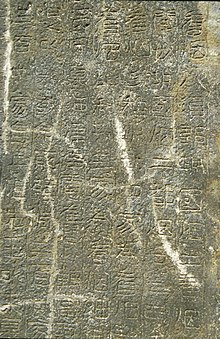Gwanggaeto Stele
| Gwanggaeto Stele | |

Detail of inscription.
|
|
| Korean name | |
|---|---|
| Hangul | 광개토왕릉비 also 호태왕비 |
| Hanja | 廣開土王陵碑 also 好太王碑 |
| Revised Romanization | Gwanggaeto wangneungbi also Hotae Wangbi |
| McCune–Reischauer | Kwanggaet'o wangneungbi also Hot'ae Wangbi |
The stele of Gwanggaeto the Great of Goguryeo was erected in 414 by Jangsu of Goguryeo as a memorial to his deceased father. It is one of the major primary sources extant for the history of Goguryeo, one of the Three Kingdoms of Korea, and supplies invaluable historical detail on his reign as well as insights into Goguryeo mythology.
It stands near the tomb of Gwanggaeto in what is today the city of Ji'an along the Yalu River in present-day northeast China, which was the capital of Goguryeo at that time. It is carved out of a single mass of granite, stands nearly 7 meters tall and has a girth of almost 4 meters. The inscription is written exclusively in Classical Chinese and has 1,802 characters.
The stele has also become a focal point of varying national rivalries in East Asia manifested in the interpretations of the stele's inscription and the place of the Empire of Goguryeo in modern historical narratives. An exact replica of the Gwanggaeto Stele stands on the grounds of War Memorial of Seoul and the rubbed copies made in 1881 and 1883 are in the custody of China and the National Museum of Japan, respectively, testament to the stele's centrality in the history of Korea and part of Manchuria.
The stele's location, in Ji'an in the northeastern Chinese province of Jilin, was key to its long neglect. Following the fall of Goguryeo in 668, and to a lesser extent the fall of its successor state Balhae in 926, the region drifted outside the sway of both Chinese and Korean geopolitics. Afterwards the region came under the control of numerous Manchurian states, notably the Jurchen and from the 16th century the Manchu.
...
Wikipedia
